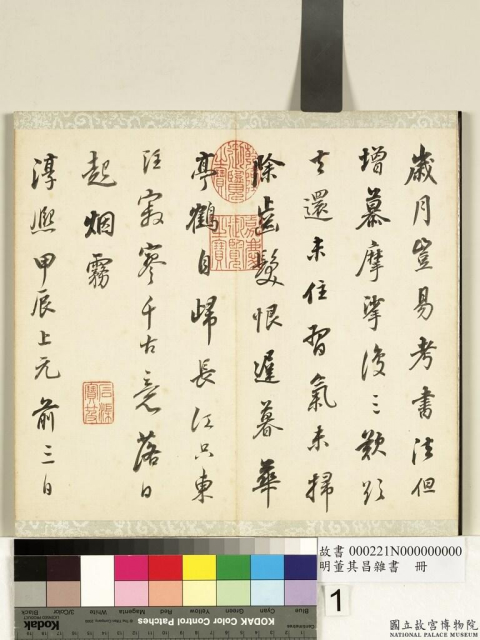明董其昌雜書 冊 臨吳琚
推薦分享
資源連結
連結到原始資料 (您即將開啟新視窗離開本站)後設資料
- 資料識別:
- 故書000221N000000002
- 資料類型:
- 類型:書法
- 型式:文字
- 著作者:
- 董其昌
- 出版者:
- 數位化執行單位:國立故宮博物院
- 日期:
- 明神宗萬曆三十九年(1611)
- 格式:
- 本幅 26.1x29.6公分、全幅 28.4x29.6 公分
- 語言:
- 漢文
- 關聯:
- 石渠寶笈初編(長春書屋),下冊,頁1173&*故宮書畫錄(卷三),第一冊,頁120-121&*Tung Ch’i-ch’ang (1555-1636) was a native of Hua-t’ing, Kiangsu province. His style name was Hsüan-tsai and he was known by the sobriquet Ssu-pai. He obtained the chin-shih degree in 1589 and went on to become the Minister of the Ministry of Rites. He was given the posthumous title Wen-min. Tung was exceptionally talented and accomplished as a calligrapher and painter; he was also a collector and an outstanding connoisseur. He frequently made free-copies and copies of old calligraphic works to the point that he would forget to eat or sleep. His ingenious semi-cursive and standard scripts were considered the best of his time. These leaves, which are copies of Wu Chü’s calligraphy, are in an album of miscellaneous works written in 1611, the year after Tung retired to Sungkiang from his official post in Fukien. On this work Tung copied five poems written by Wu Chü about seeing the Yi-ho inscription on Mt. Chiao. Tung regarded Wu’s calligraphy as bearing too close a resemblance to Mi Fu’s, but noted that its handsome spirit surpassed Mi’s. This album is not only handsomely spirited, but is imbued with an even greater breath of clarity. &*董其昌(西元一五五五-一六三六年),字玄宰,號思白,江蘇華亭人。萬曆十七年(一五八九)進士,官至禮部尚書,諡文敏。天才雋逸,善書畫,富收藏,尤精鑑賞。臨摹書蹟,至忘寢食。行楷之妙,稱絕一代。 臨吳琚帖為雜書冊中之三開,書於萬曆三十九年(一六一一),時董氏甫自閩歸隱松江年餘。所臨為吳琚遊焦山觀瘞鶴銘五言詩,董氏評吳琚酷似米芾,而俊峭則有過之,此冊則俊峭外,更多清整之氣息。
- 管理權:
- 國立故宮博物院
授權聯絡窗口
- 國立故宮博物院圖像授權、出版授權、影音資料授權-申請流程說明
http://www.npm.gov.tw/zh-TW/Article.aspx?sNo=03003061






